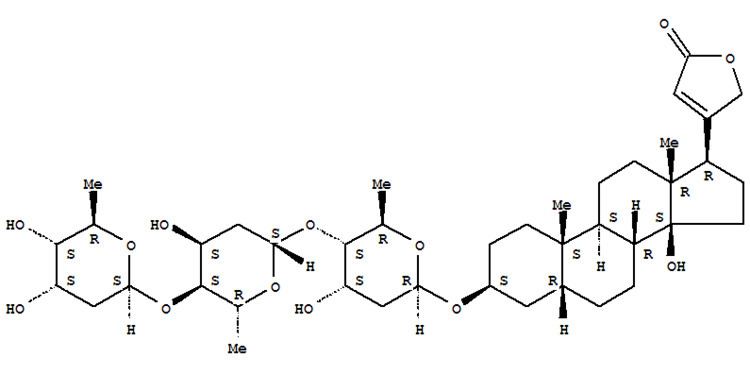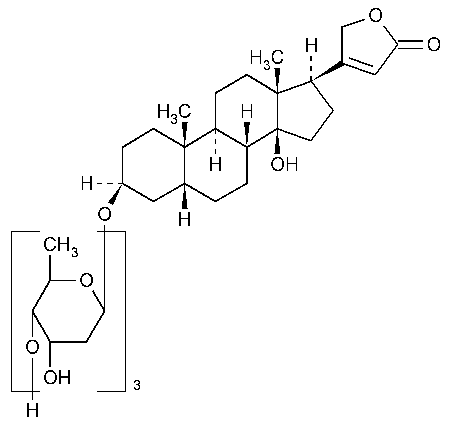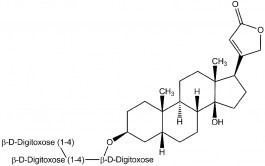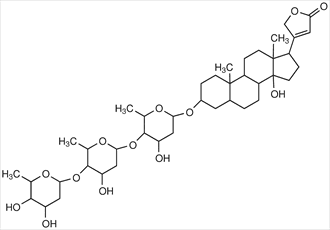Trade names Digitaline Bioavailability 95% (Oral) Biological half-life 5~7 days Molar mass 764.939 g/mol | ATC code C01AA04 (WHO) Metabolism CAS Number 71-63-6 CAS ID 71-63-6 | |
 | ||
Digitoxin is a cardiac glycoside. It is a phytosteroid and is similar in structure and effects to digoxin (though the effects are longer-lasting). Unlike digoxin (which is eliminated from the body via the kidneys), it is eliminated via the liver, so could be used in patients with poor or erratic kidney function. However, it is now rarely used in current Western medical practice. While several controlled trials have shown digoxin to be effective in a proportion of patients treated for heart failure, the evidence base for digitoxin is not as strong, although it is presumed to be similarly effective.
Contents

Toxicity
Digitoxin exhibits similar toxic effects to the more commonly used digoxin, namely: anorexia, nausea, vomiting, diarrhea, confusion, visual disturbances, and cardiac arrhythmias. Antidigoxin antibody fragments, the specific treatment for digoxin poisoning, are also effective in serious digitoxin toxicity.
History

The first description of the use of foxglove dates back to 1775. For quite some time, the active compound was not isolated. Oswald Schmiedeberg was able to obtain a pure sample in 1875. The modern therapeutic use of this molecule was made possible by the works of the pharmacist and the French chemist Claude-Adolphe Nativelle (1812-1889). The first structural analysis was done by Adolf Otto Reinhold Windaus in 1925, but the full structure with an exact determination of the sugar groups was not accomplished until 1962.
Use in fiction

Digitoxin is used as the murder weapon in Agatha Christie's Appointment with Death, Elizabeth Peters' Die For Love and CSI, season 9, episode 19: "The Descent of Man". Digitalis was also used as a poison in the James Bond film "Casino Royale" (2006) as well as in the episode "Uneasy Lies the Crown" on Columbo, season 9, episode 5 (1990), "Affair of the Heart" on McMillan and Wife, season 6, episode 5 (1977) and on Murder 101: "College can be a Murder". Also used in several episodes of Murder She Wrote.

In The Decemberists's song, "The Rake's Song" on the The Hazards of Love album, the narrator murders his daughter by feeding her foxglove.
Use in cancer chemotherapy

Digitoxin and related cardenolides display potent anticancer activity against a range of human cancer cell lines in vitro but the clinical use of digitoxin to treat cancer has been restricted by its narrow therapeutic index. Digitoxin glycorandomization led to the discovery of novel digitoxigenin neoglycosides which displayed improved anticancer potency and reduced ionotropic activity (the perceived mechanism of general toxicity). Steroidal glycosides based upon this latter discovery served as the basis for the development of a new class of antibody-drug conjugate known as extracellular drug conjugates (EDCs) as first in class agents to treat cancer by the biotechnology company Centrose.
